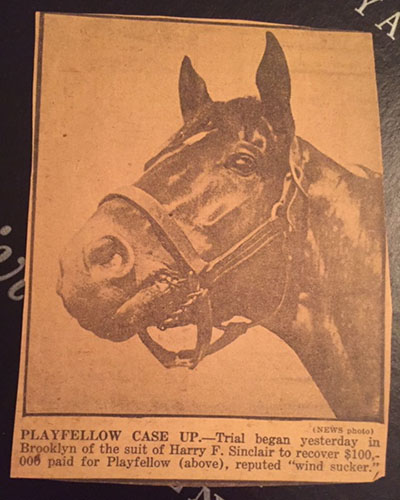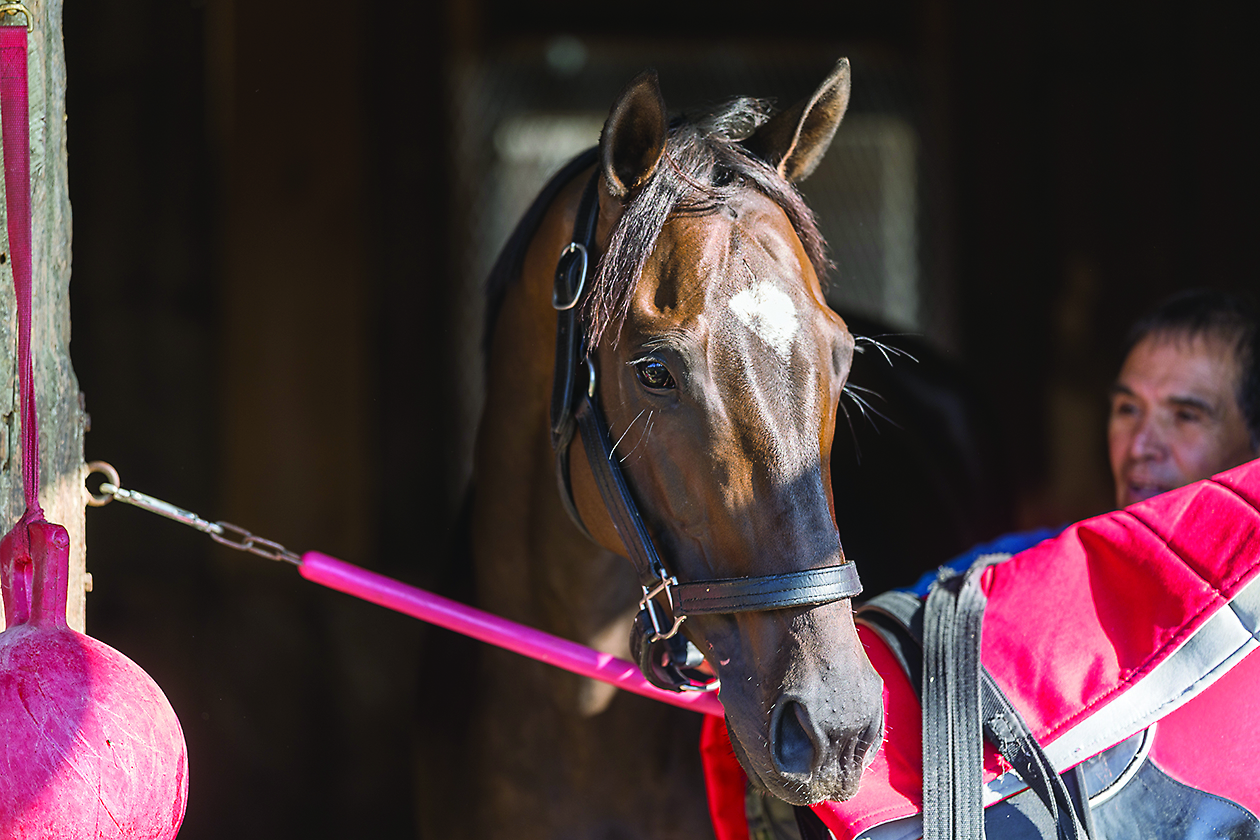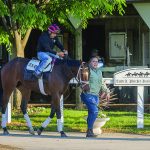In 1921, a headline-grabbing soap opera began in the racing world when Playfellow, a 3-year old full brother to Man o’ War was sold for $100,000, roughly $1.5 million in today’s money. The buyer was oil-baron Harry F. Sinclair, who later became notorious for his central role in the Teapot Dome oil scandal.
My grandfather, Hall of Fame racehorse trainer James E. “Sunny Jim” Fitzsimmons, was the original trainer of Playfellow. He regretfully found himself in the middle of the mess that followed the Playfellow sale, a debacle that seriously challenged the good-hearted nature that earned him the nickname, “Sunny Jim.”
More than that, he felt cheated of the chance to train a really good horse.
The story really begins in 1918, when my grandfather (acting for the Quincy Stable owner, James F. Johnson) attended the dispersal sale of August Belmont’s Thoroughbred stable. That stable included the legendary Man o’ War – then a yearling.
Sunny Jim actually started bidding for Man o’ War, but dropped out when the price neared $5,000 ($95,000 in today’s money). At the time, he did not feel comfortable paying more than that for a horse, in the stable owner’s absence. This was a decision he regretted immediately, and one that haunted him for his entire life.
In 1919, he got a second bite at the apple.
Again acting for Johnson’s Quincy Stable, he travelled to Kentucky and purchased a number of yearlings. One of them was Playfellow, a good-looking full brother to Man o’ War; and he thought he had a winner. It took him awhile to develop the horse, but in the spring of his 3-year-old year, Playfellow was putting in some really fast times in his morning workouts. So, my grandfather nominated him to run in a number of major stakes races that year.
On June 18, 1921, The New York Herald took up the saga:
“Until three weeks ago, Playfellow wasn’t even considered a fair plater (a low-level racehorse). He was branded as a false alarm and not worth the $1,800 Fitzsimmons paid for him…He was ridiculed and scorned by all race-goers and often called a disgrace to his illustrious brother. But Fitzsimmons knew better. He said he had a great colt in him, and time and again declared he would prove it before the end of this season.
“On June 1, Fitzsimmons sent him out against a small field of mediocre horses at Belmont Park, and he galloped home in first. His victory wasn’t an impressive one and he earned little fame and only $700. Three days later he came forth again, this time against a larger field and much better horses. Again he won, and in startling fashion. He galloped all the way and travelled the one-mile route in the fast time of 1:36 4/5. So impressive was his race that three wealthy sportsmen went in quest of him. Each of them offered $100,000 for him.”
 After some back and forth, Playfellow’s owner sold him for $100,000 to Sinclair’s Rancocas Stable. My grandfather wasn’t happy to lose the horse, but he took some pride in Playfellow’s development. He added that, “…had Mr. Johnson been a man of Mr. Sinclair’s wealth, I never would have counseled him to part with Playfellow.”
After some back and forth, Playfellow’s owner sold him for $100,000 to Sinclair’s Rancocas Stable. My grandfather wasn’t happy to lose the horse, but he took some pride in Playfellow’s development. He added that, “…had Mr. Johnson been a man of Mr. Sinclair’s wealth, I never would have counseled him to part with Playfellow.”
But, things quickly came crashing down.
After Playfellow had run three races in the Rancocas silks (twice finishing second, but then finishing last in a three-horse field, while also exhibiting some distress), Sinclair asked for his money back, claiming that the horse was a “cribber” and a “wind sucker.” A cribber is a horse that gnaws wood, inhaling air and wood slivers. A wind sucker stretches out his neck to inhale large quantities of air that fill his stomach. Both involve bad habits that could affect a horse’s performance on the track.
Johnson scoffed at Sinclair’s demand, arguing both that Playfellow was fine when he owned him (a fact attested to by the track veterinarian), and that there are never any guarantees of the outcome when one is either buying or selling a racehorse.
The racing community was in general agreement, but Sinclair countered that Johnson had, in fact, specifically promised him that the horse was totally free of all defects, and that, therefore, he had been swindled. In December of 1921, the parties met in a Brooklyn courtroom.
In the months leading up to the trial (between June and December 1921), a spirited rivalry took place between my grandfather and the Rancocas trainer, Sam Hildreth.
Hildreth, who trained some of the best horses in the country, had been quoted several times in the press, disparaging the quality of the Quincy Stable horses that my grandfather trained. But, much to his embarrassment, my grandfather kept beating him.
The sportswriters, of course, loved it. A news account from September 29, 1921 shows how the pot was kept boiling:
“Last Wednesday in the Roslyn Handicap came the big scene in the third act, and Fitzsimmons administered the coup de grace.
“Here is the picture – Knobbie, for which the Rancocas trainer had paid Fitzsimmons $25,000 about the same time as the Playfellow sale, was in the field as the 3-10 favorite, and against him was a poor old selling plater with a gnarled ankle from the Quincy Stable, named Copper Demon. A selling plater, mind you, in against a $25,000 stakes horse, and all the other starters withdrawn, leaving it a match race between the two. And the selling plater won!”
Copper Demon’s victory, it was noted, brought the winnings for the Fitzsimmons-trained horses to $22,000 for the race meeting, twice that of Hildreth’s horses.
At the trial in December, the courtroom was packed with owners, trainers, jockeys and stable boys, some of whom were said to have travelled hundreds of miles. A report on the second day of the trial stated:
“The crowd…was even larger than…when the trial opened. Justice Frank Gannon, Jr. displayed every consideration for the spectators, and, although the room was packed and persons were standing six deep in the rear, he did not order the doors closed…”
The Herald reported that, “Fitz was on the witness stand for nearly two hours and declared emphatically that he had never seen Playfellow crib or suck wind during the two years he trained him.” He testified, however, that he had once been told the horse might have cribbed, and also once been told that he might have sucked wind. Neither he nor his foremen could confirm the existence of a problem – despite frequent monitoring. However, as a preventive measure and out of concern for the horse, he had Playfellow wear a special perforated mouth bit.
My grandfather said that he did not report any of this to Johnson, the Quincy Stable owner, because he had not confirmed that there was an actual problem; and the horse was running well. On the stand, he produced a workbook with all of Playfellow’s workout times in it, stating that “He examined the colt after all of these trials, and not once had seen him in distress, despite the fact that three of them were exceptionally fast” workouts.
He added that he “…had learned by experience that Playfellow had worked and raced better without blinkers than with them, and that he ran better without being whipped.” He said he had explained all of this to Hildreth, but the Rancocas trainer had ignored his advice on these points. Sunny Jim stated that, while he was at a loss to explain Playfellow’s problem in his last race, he thought the addition of blinkers and use of the whip could be part of the problem. A variety of other possible causes for Playfellow’s distress in his last race came up during the trial. These included overfeeding, overwatering and the indigestion problems known to bother the sons and daughters of Fair Play, the father of Man o’ War and Playfellow.
In his testimony during the trial, Johnson noted that, shortly after the sale of Playfellow, he told Hildreth that he had just purchased a very good horse. Hildreth responded by joking that it was good then that Playfellow had not raced against the Rancocas Stable’s champion Grey Lag, when the latter won Brooklyn Handicap. At this point, my grandfather chimed in, “I don’t know about that, but … don’t kid yourself. You don’t know what kind of a horse you have bought.” My grandfather really thought that Playfellow could be a world-beater.
Sinclair’s attitude in the Playfellow suit was reportedly colored by the embarrassing outcome of another of his recent high-dollar purchases. In 1920, he bought the 2-year old colt Inchcape for $150,000 – then the highest price ever paid for a 2-year old. Sinclair purchased Inchcape after the horse had run a few very good races, but almost immediately, the horse came down with a serious skin disease that kept him from running. And when the skin problem was finally cleared up, Inchcape came up lame, and then later, lame again. Sinclair’s friends had called him a “sucker” for having paid so much for Inchcape. And so, when the term “sucker” came up during the Playfellow trial, it caused considerable laughter among the crowd, given the allegation that Playfellow was a “sucker.”
Whether or not wind sucking or cribbing really prevented a horse from doing well on the track was the subject of spirited discussion, both during and after the trial. Indeed, several champions were said to have displayed one of these traits or the other. After considerable contradictory testimony on this topic during the trial, The Brooklyn Daily Eagle concluded, “So the question whether a cribber or windsucker is unsound is still debatable, and is likely to remain so till the crack of doom.” But given New York State law’s general “Caveat emptor” or “buyer beware” stance, the only thing that could theoretically void the Playfellow sale was Sinclair’s argument that a false warranty had been provided.
As noted by one reporter covering the trial:
 “The case hangs on the question (of) whether Johnson gave a warranty of soundness in selling Playfellow to Sam Hildreth, who was acting on behalf of Sinclair, and whether said warranty, if he gave it, was fraudulent.” (Photo left of Sunny Jim and the Johnsons of Quincy Stable)
“The case hangs on the question (of) whether Johnson gave a warranty of soundness in selling Playfellow to Sam Hildreth, who was acting on behalf of Sinclair, and whether said warranty, if he gave it, was fraudulent.” (Photo left of Sunny Jim and the Johnsons of Quincy Stable)
The first trial ended with a hung jury. A second trial, in March 1922, resulted in the surprising decision that Johnson must return the $100,000 he had been paid for Playfellow, and accept the horse back. The New York Times reported that the spectators at the trial were shocked. Many had even placed bets on the outcome of the trial, with the odds being 10-1 in favor of Johnson.
Johnson appealed the decision, and Playfellow entered a kind of limbo. Johnson would not take him back, and Sinclair wouldn’t race him under his colors. Worried about the effects of a long layoff, and confident that he could show Playfellow was a winner, my grandfather convinced Johnson to make Sinclair a proposition that was described by the Herald, as follows:
“Johnson will tell them (Sinclair and Hildreth) he is willing to have Fitzsimmons take the colt, pay all the training expenses, and turn over all the money he might win to any charity that Mr. Sinclair and Mr. Hildreth might name, pending the appeal of the case. He will tell them that he will do this to demonstrate to the racing public that Playfellow is a first-rate horse.”
Sinclair and Hildreth would not hear of it, and so Playfellow languished on the Rancocas farm in Jobstown, New Jersey. In July 1922, the Appellate Court confirmed the lower court’s decision in the case; and Johnson had to return the $100,000 to Sinclair and take Playfellow back.
Regrettably for my grandfather, too much time had gone by. Playfellow returned to racing in October 1922 at Laurel Park in Maryland, but he never lived up to his potential. As reported in the Herald, while Playfellow received some exercise during his layoff, “…the lack of actual participation in racing seems to have had a deleterious effect. (As a result) … the prediction of the trainer, Fitzsimmons, that Playfellow would demonstrate that he was worth the money paid for him has failed to come true…”
For his part, however, Hildreth apparently wasn’t so sure that my grandfather wasn’t right about the horse; and he made a point of scratching any Sinclair horse entered in the same race as Playfellow. As reported in Collyer’s Eye, “It is whispered about the clubhouse that the real reason for Hildreth’s determination to avoid a meeting with Playfellow is fear of a beating…and there is a general suspicion that Playfellow can race better than he has shown.”
But, as it turned out, the opportunity was lost. This disappointed my grandfather, and greatly embittered Johnson, with the result that they parted company in 1923. By the end of the year, however, my grandfather was training for William Woodward’s Belair Stud. There, he trained a great many champions, including Triple Crown winners Gallant Fox (1930) and Omaha (1935), as well as Horses of the Year Granville (1936), Johnstown (1939) and Nashua (1955).
In April 1922, one month after the Playfellow decision, Sinclair’s image as a respectable businessman came under serious assault. Information emerged that Sinclair had been granted an oil lease in Teapot Dome, Wyoming, by Secretary of the Interior Albert Fall, without the required competitive bidding. Fall was subsequently convicted of accepting bribes in exchange for granting oil leases, and Sinclair spent six and a half months in jail for hiring a detective agency to shadow each member of the jury in the bribery trial. Since the Playfellow case hinged on the veracity of a claim of a verbal “warranty,” my grandfather was left to wonder whether it would have made any difference in the jury’s decision, if Sinclair’s questionable business practices had come to light a few weeks sooner.
In 1932, 10 years after the Playfellow court decision, James Johnson thought he would have the last laugh in the Playfellow affair. During the previous year, Sinclair had sold all his yearlings, and Johnson had purchased one of them for $1,200. The colt looked so good early on that Johnson sarcastically named him Repaid. And, after he won the Junior Champion Stakes in October 1932, The News Leader ran an article titled, “Repaid’s Winnings Avenging Owner’s $100,000 Grudge.” After that, however, Repaid’s performance declined.
The last laugh perhaps went to my grandfather. When Johnson died in 1933, my grandfather bought Repaid from his estate. He hadn’t personally owned a horse in 20 years, but he thought this horse was still pretty good, so he took a chance. Thus it was, that his cherry and orange silks once again crossed the finish line first, as Repaid handily won the Orange Blossom Stakes at Hialeah. This led to the Brooklyn Daily Eagle headline, “Repaid, At Journey’s End, Starts Settling An Account of Long Standing: Colt’s Victory Recalls Sinclair’s ‘Unsound’ Suit for $100,000.”
Bill Fitzsimmons is a resident of Potomac, Maryland, and Saratoga Springs, New York. A native of Brooklyn, New York, he spent his summers at Lake Desolation where his “Grandpop” – James “Sunny Jim” Fitzsimmons – had family camps. Bill is an alumnus of Cornell (BA) and Duke (MA) Universities. He is retired from the National Institutes of Health (NIH), where he served as Executive Officer for the National Institute of Mental Health (NIMH).








